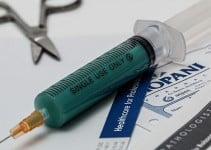Like many women, you’ve probably grown up using pads and tampons when you have your period. There’s nothing wrong with this, especially if you’re happy with the brand you use and get the best possible protection and comfort from it.
However, you have to realize that these menstrual products are not the only options available. If you’re willing to try something new, you can go for menstrual cups.
Keep on reading if you want to know what a menstrual cup is and how to use it.
Unlike a tampon, a menstrual cup is designed to collect menstrual fluid and it can last for up to ten years [1]. This cup will act as a barrier and you can clean and re-use it. In addition, a menstrual cup has proven to leak less, is comfortable to wear and is associated with fewer health risks.
You are also less likely to have vaginal infections when wearing this cup [2]. There are two types, a flexible, soft, and disposable one that looks like a diaphragm and a bell-shaped reusable one that is made of latex or silicone.
How to Use a Menstrual Cup
It is very important to read the instructions carefully before using the menstrual cup. Whenever you decide to use it, you should first try to insert it at home in the privacy of your bathroom.
You might be tempted to use it on a dry run before your period, but you should not do this because it’s usually more lubricated and the cervix can be in a different position when you are menstruating.
Another suggestion is to practice some different fold options. The C fold is not the best technique for most women because the widest section of the cup will be at the beginning.
To get started, you should use soap to wash your hands and water to rinse the cup to remove any dirt or dust. You should also boil the cup as well when using for the first time.
Bear in mind that soap should not be used on the menstrual cup as it could trigger yeast infections among other problems.
After cleansing the cup and your hands, you should relax to insert it inside your vagina. Tensing your pelvic muscles can make the insertion difficult or painful. Try to get into a position that is comfortable.
This can be over the toilet or squatting down inside the shower or tub; standing with one leg positioned on the edge of the bathtub or toilet; positioning your back against the bathroom wall in a squat, or lying flat on the floor with your legs apart and knees up.
After that, you should try to find your cervix. This can be done by sticking a finger in your vagina to find the cervix that will feel much like your nose tip. It’s a small, spongy nub with a dent in the middle.
Aim the cup towards your cervix to insert it. Fold the cup, use one hand to hold it, spread your labia apart and use the other hand to find the vagina opening.
At this time, you should push in the cup at an angle of around 45 degrees towards the pubic bone. You should hear the cup pop open. When this happens, you need to continue pushing the cup until its comfortable inside.
After that, you need to wait for up to twelve hours. You’ll have to empty the cup more often if the blood is flowing heavy during your period.
Prepare to do some experimenting when using the cup for your first cycle to determine how long the cup can be left inside before leaking. A good recommendation is for you to wear a panty liner as a backup.
When you are ready to remove the cup, you can bear your muscles down for it to go down farther. You should keep on doing this until the stem is reached. Wiggle the menstruation cup down, and back and forth. Pinch the base as this will help to break the vacuum and make it easier to take out the cup.
Be sure to remove the cup in an upright position after reaching the opening of your vagina to reduce spillage. Use one of your fingers to fold the menstrual cup in a C or punch down fold before removing if the rim is too wide to for you to take out comfortably.
The contents can spill out from the back while you are removing the cup if you are doing it over a toilet.
After dumping the contents of the menstrual cup in a sink or toilet, you can use pure water to rinse it out. While holding it under the water, you can bend at the suction holes to remove menstrual fluid.
If it is too slippery when done, you can dry it for reinsertion.
What Are Their Advantages Over Tampons and Pads?
They’re cheaper
Menstrual cups cost around $30. It can seem expensive at first glance, but when you do the calculations, you’ll see that it’s actually cheaper in the long run. Most cups can be used for about a year, so you’ll spend only $30 on menstrual products for the next 12 months.
Pads and tampons, on the other hand, can range from six cents to more than $1 per piece (or around $120 per year, as women’s blog Jezebel points out), depending on their absorbency and whether you buy in bulk or not. Compare these prices with each other, and you’ll see that menstrual cups are the more cost-efficient option.
They can be used for a longer time
Tampons should only be used up to 8 hours; wear them longer than that, and you’ll run the risk of developing toxic shock syndrome, which can be highly fatal. This means you can’t wear them to bed, especially if you’re planning to get 8 hours of sleep or more.
Pads can be worn for any length of time, but ideally they should be changed every three to four hours to prevent odors from forming.
Menstrual cups, on the other hand, can be worn 12 hours straight. This means you can wear them to bed without having to wake up in the middle of the night to change them.
You can also wear them when you go hiking or camping, when you take long bus rides, or when you visit a place where you’re not sure if there will be a bathroom you can use. (Of course, when you have heavy periods, you’ll need to empty your menstrual cup more often to prevent leaking.)

They don’t contain harmful chemicals
Most pads and tampons contain chlorine and rayon as well as various dyes and fragrances. These can cause irritation, particularly in those that have sensitive skin. But, even if your skin isn’t that sensitive, you’ll still have to be careful about these chemicals.
Remember: you’re essentially exposing yourself to them several days each month, and the trace amounts you get from each exposure can build up in your body over time.
To avoid these substances, you can switch to organic pads and tampons, which are more expensive than regular products. Or you can use menstrual cups, which don’t contain any additives. With cups, the only thing you should be careful of is latex, but it can be easily solved.
If you have a latex allergy, simply buy a menstrual cup that’s made of 100 percent silicone instead of rubber, and you’re good to go!
They can help reduce odors
When your period blood comes in contact with your natural discharges, it can alter the chemistry of your vagina and cause strange odors to develop. It can even create an environment that’s ideal for yeast and bacterial infections, which can pave the way to funkier smells.
This is where menstrual cups can help: since they keep your period blood from flowing freely through your vagina, they can help you smell fresh for longer.
These are just some of the advantages that menstrual cups bring. Give them a try and see how they can help you manage your period in a better way.
View Best Menstrual Cup Offers on Amazon
Now that you know what a menstrual cup is and how to use it, you should remember that it might take some time for you to get accustomed to using one. It has a learning curve of around 3 to 4 cycles, but once this time passes you can enjoy many benefits in health, comfort, hygiene, reliability, and convenience.
References



